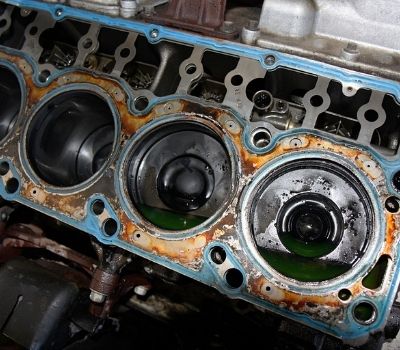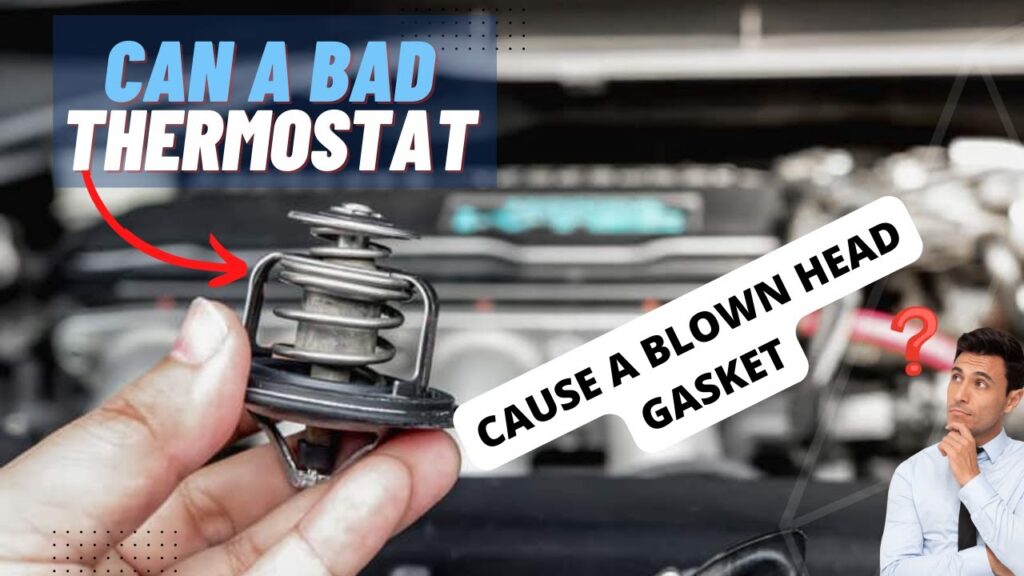- Pet Food Dispenser With Camera: The Ultimate Way to Monitor Your Pet’s Meals! - November 16, 2023
- Automatic Pet Feeder With Timer: A Time-Saving Solution for Busy Pet Owners - November 16, 2023
- Pet Tracker for Small Dogs: Discover the Ultimate Solution for Tracking Your Furry Friend - November 16, 2023
A bad thermostat can cause a blown head gasket due to overheating. If the thermostat gets stuck in a closed position, it will not allow coolant to reach the radiator, leading to engine overheating and potentially causing severe damage to the head gasket.
Understanding A Bad Thermostat
A bad thermostat can cause a blown head gasket by leading to engine overheating. When a thermostat gets stuck closed, it prevents coolant from reaching the radiator, causing the engine to overheat and potentially causing severe damage. Knowing the symptoms of a bad thermostat can help prevent this issue.
A bad thermostat in a car can lead to various issues, including overheating and potential damage to the engine. It is crucial to understand the function of a thermostat, the symptoms of a bad thermostat, and how to identify if it is stuck open or closed.
What Is A Thermostat?
A thermostat is a small device located between the engine and the radiator in a car’s cooling system. Its main function is to regulate the flow of coolant to maintain the engine’s optimal temperature. When the engine is cold, the thermostat remains closed, preventing coolant from circulating.
As the engine warms up, the thermostat opens, allowing coolant to flow through the radiator and cool the engine.
Function Of A Car Thermostat
- Regulates engine temperature: The thermostat helps maintain the engine at its ideal operating temperature by controlling the flow of coolant.
- Improves fuel efficiency: By keeping the engine at the right temperature, a functional thermostat ensures optimal fuel combustion, leading to increased fuel efficiency.
- Protects the engine: Proper regulation of temperature prevents the engine from overheating, which can cause damage to components such as the head gasket and cylinder head.
Symptoms Of A Bad Thermostat
- Engine overheating: One of the most noticeable signs of a faulty thermostat is an engine that consistently overheats. This occurs when the thermostat fails to open and allow coolant to flow through the radiator, leading to excessive heat buildup.
- Low coolant levels: A bad thermostat may cause coolant levels to drop rapidly due to improper flow and circulation. Regularly checking and replenishing coolant reservoir levels is crucial to prevent engine damage.
- Erratic temperature gauge: If the temperature gauge on the dashboard fluctuates unexpectedly or remains stuck in the cold position, it could indicate a malfunctioning thermostat.
- Poor heating performance: When a thermostat gets stuck open, it prevents the engine from reaching its optimal temperature, resulting in inadequate cabin heating during cold weather conditions.
- Coolant leaks: In some cases, a bad thermostat can cause coolant leaks. If you notice puddles of coolant underneath your vehicle or smell a sweet, antifreeze-like odor, it could be a sign of a leak.
Identifying A Stuck Open Thermostat
- Coolant flow: A stuck open thermostat disrupts the thermal balance by allowing coolant to circulate continuously, even during the cold startup phase.
- Slow engine warm-up: If your engine takes an unusually long time to warm up, it may indicate a thermostat that is stuck open, not allowing the engine to reach its optimal operating temperature.
- Lack of heat: With a stuck open thermostat, the engine may never achieve its normal operating temperature, resulting in poor heat output from the vehicle’s heating system.
Impact Of A Closed Thermostat On Coolant Flow
- Restricted coolant flow: When a thermostat remains closed, it blocks the flow of coolant through the radiator, preventing the engine from cooling properly.
- Increased risk of overheating: Without sufficient coolant flow, the engine is susceptible to overheating, potentially causing damage to the head gasket, cylinder head, or even engine failure.
- Limited effectiveness of cooling system: A closed thermostat prevents the radiator from doing its job effectively, compromising the overall cooling system’s performance.
Understanding a bad thermostat is essential for recognizing the early signs of a malfunctioning one. By being aware of the symptoms and impact of a stuck open or closed thermostat, you can take prompt action to prevent further engine damage and maintain optimal performance.
Regular maintenance and inspections can help identify and address thermostat issues before they lead to more severe consequences.
Effects Of A Bad Thermostat On The Engine
A bad thermostat can cause a blown head gasket by causing overheating in the engine. If the thermostat gets stuck in a closed position, it prevents coolant from reaching the radiator and leads to engine overheating, potentially causing severe damage.
:
A bad thermostat can have several detrimental effects on the engine. Here are the key effects to be aware of:
Overheating Engine:
- When the thermostat gets stuck in the closed position, it prevents the coolant from reaching the radiator. This lack of coolant flow can lead to an overheating engine.
- If the engine overheats, it can cause severe damage to various engine components, including the head gasket.
Engine Light Indicator:
- A malfunctioning thermostat can trigger the engine light indicator on the dashboard.
- This warning light is designed to alert you to potential issues with the engine, including problems with the thermostat.
Delayed Temperature Gauge Response:
- A bad thermostat may cause the temperature gauge on the dashboard to respond slowly or inaccurately.
- This delay in temperature gauge response can make it difficult for you to monitor the engine’s temperature, potentially leading to further damage if not addressed promptly.
Poor Heating Performance:
- If the thermostat fails to regulate the flow of coolant properly, it can result in poor heating performance inside the vehicle.
- This means that the cabin may not warm up efficiently even when the heater is turned on, leading to discomfort during cold weather.
Leaking Coolant:
- In some cases, a bad thermostat can contribute to coolant leakage.
- The thermostat housing or seal may become damaged or worn out, causing coolant to leak from the system.
- This coolant loss can lead to engine overheating and potential damage if not addressed promptly.
It’s important to address any issues with a bad thermostat promptly to prevent further damage to the engine. Regular maintenance and inspection can help identify and resolve thermostat problems before they cause significant harm.
Can A Bad Thermostat Lead To A Blown Head?
A bad thermostat can potentially lead to a blown head gasket. If the thermostat gets stuck in a closed position, it can prevent coolant from reaching the radiator, causing the engine to overheat and resulting in severe damage.
The Relationship Between A Bad Thermostat And Blown Head:
- A bad thermostat can indirectly contribute to a blown head gasket by causing the engine to overheat.
- When a thermostat is faulty, it can get stuck in either the closed or open position, disrupting the proper flow of coolant through the engine.
- If the thermostat is stuck closed, coolant cannot reach the radiator, leading to increased heat buildup in the engine.
- The excessive heat can cause the cylinder head to warp or crack, resulting in a blown head gasket.
- Therefore, while the thermostat itself may not directly cause a blown head gasket, its malfunction can create conditions that can lead to this severe engine damage.
Corrosion And Aging Impact On Thermostat Functionality:
- Over time, a thermostat can become corroded or experience wear and tear due to aging.
- Corrosion and aging can affect the thermostat’s ability to open and close properly.
- Corrosion can result in the thermostat getting stuck in the closed position, preventing the flow of coolant and causing engine overheating.
- Aging can cause the thermostat to lose its calibration, leading to inaccurate temperature regulation.
- Both corrosion and aging can compromise the overall functionality of the thermostat, increasing the risk of engine overheating and potential damage to the head gasket.
Mechanism Of Engine Overheating Due To A Bad Thermostat:
- When a thermostat is faulty, it may fail to open at the correct temperature.
- If the thermostat does not open, coolant cannot flow from the engine to the radiator, where it is cooled down.
- Without proper cooling, the engine temperature rises, resulting in overheating.
- The overheated engine can lead to various problems, including a blown head gasket.
- It is crucial to address thermostat issues promptly to prevent engine overheating and subsequent damage.
Potential Damage Caused By An Overheated Engine:
- An overheated engine can cause significant damage to various engine components.
- The head gasket, in particular, is at risk of failure due to extreme temperature fluctuations.
- When the engine overheats, the cylinder head and engine block may expand at different rates, causing the head gasket to blow.
- A blown head gasket can lead to coolant leakage, oil contamination, decreased engine performance, and potentially catastrophic engine failure.
- It is essential to take immediate action if your engine is overheating to prevent further damage and potential costly repairs.
Can A Blown Head Gasket Impact The Thermostat?:
- While a blown head gasket does not directly impact the functionality of the thermostat, it can indirectly affect its performance.
- When a head gasket fails, coolant may mix with the engine oil or escape externally.
- This coolant loss or contamination can lead to a decrease in coolant levels.
- A low coolant level can hinder the thermostat’s ability to function correctly, potentially causing temperature regulation issues.
- It is essential to address both blown head gasket and thermostat problems to ensure optimal engine performance and prevent further damage.

Credit: drivingyard.com
Frequently Asked Questions Of Can A Bad Thermostat Cause A Blown Head
What Damage Can A Bad Thermostat Cause?
A bad thermostat can cause overheating, leading to severe engine damage.
Can A Blown Head Gasket Affect The Thermostat?
A blown head gasket is unlikely to affect the operation of the thermostat on the radiator.
How To Tell The Difference Between A Bad Thermostat And Head Gasket?
A bad thermostat can cause overheating and damage to your engine. Symptoms include poor heating performance and an engine that takes longer than usual to reach the halfway mark on the temperature gauge. On the other hand, a blown head gasket can cause coolant to disappear or an overheating engine.
What Can Be Mistaken For A Blown Head Gasket?
Common symptoms that can be mistaken for a blown head gasket include disappearing coolant and an overheating engine without an apparent cause.
Can A Bad Thermostat Cause A Blown Head Gasket?
No, a bad thermostat itself cannot directly cause a blown head gasket. However, it can lead to an overheating engine, which may eventually cause damage to the head gasket.
Conclusion
To conclude, a bad thermostat can indeed cause a blown head gasket. The most common symptom of a faulty thermostat is overheating, which can lead to severe damage to the engine. When a thermostat gets stuck in a closed position due to corrosion or aging, it prevents coolant from reaching the radiator, causing the engine to overheat.
While a blown head gasket can affect multiple systems in a vehicle, it is less likely to impact the operation of the radiator’s thermostat. It is important to note that head gaskets rarely need to be replaced unless the engine has suffered significant overheating, while thermostats should be replaced if they stick open or shut.
It is essential to diagnose the problem correctly to avoid mistaking other symptoms, such as disappearing coolant or an overheating engine, for a blown head gasket. Regular maintenance and addressing thermostat issues promptly can help prevent costly engine damage.


